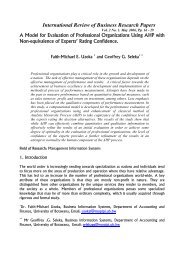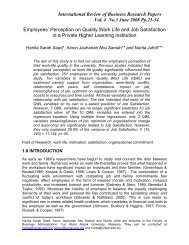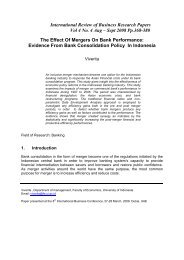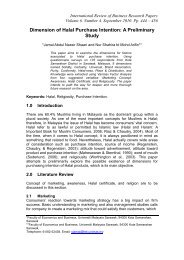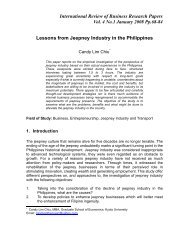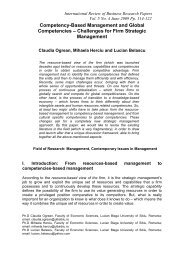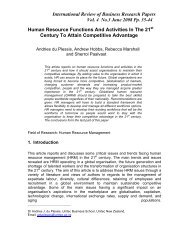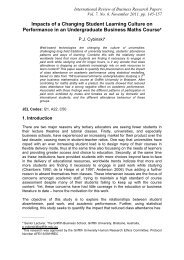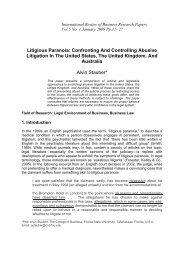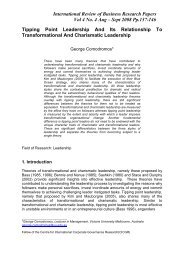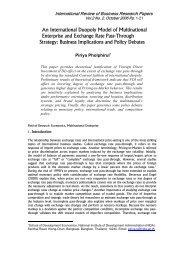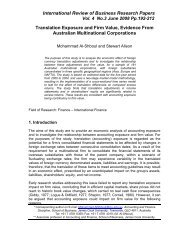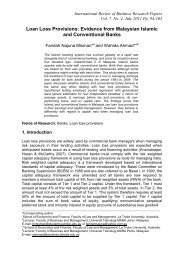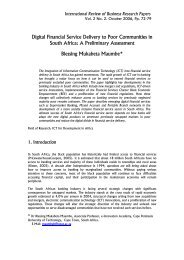The Dynamic Relationship Between Accounting Numbers and ...
The Dynamic Relationship Between Accounting Numbers and ...
The Dynamic Relationship Between Accounting Numbers and ...
Create successful ePaper yourself
Turn your PDF publications into a flip-book with our unique Google optimized e-Paper software.
International Review of Business Research Papers<br />
Vol. 5 No. 5 September 2009 Pp. 16-24<br />
<strong>The</strong> <strong>Dynamic</strong> <strong>Relationship</strong> <strong>Between</strong> <strong>Accounting</strong><br />
<strong>Numbers</strong> <strong>and</strong> Share Prices on the Jakarta Stock<br />
Exchange<br />
Keywords:<br />
Eko Suwardi*<br />
<strong>The</strong> objective of this study is to investigate the nature of the relationship<br />
between accounting numbers <strong>and</strong> share prices of firms listed on the Jakarta<br />
Stock Exchange for the period 1992-2001, using dynamic modelling principles<br />
in addition to the more usual cross sectional analysis. <strong>The</strong> results of this study<br />
show that the accompanying equilibrium correction relationship between<br />
market <strong>and</strong> book values for firms listed on the Jakarta Stock Exchange (JSX)<br />
can often be identified using accounting regressors. <strong>The</strong> models are typically<br />
more informative, plausible <strong>and</strong> consistent than cross sectional models <strong>and</strong><br />
are useful in interpreting the context in which the market to book relationship<br />
exists in Indonesia. A possibly surprising result is that in Indonesia, compared<br />
to similar models estimated using US data, the book value of net assets<br />
seems to have a stronger relationship with market value. This may be a<br />
function of the relative importance of financial statements as a source of<br />
information on the JSX.<br />
<strong>Dynamic</strong> relationship, accounting numbers, share prices, equilibrium<br />
correction.<br />
1. Introduction<br />
<strong>The</strong> objective of this study is to investigate the nature of the relationship<br />
between functions of accounting numbers <strong>and</strong> functions of stock prices on the<br />
Jakarta Stock Exchange (JSX). An important variant of this type of research<br />
has become known in the literature as relating to the ‘value relevance of<br />
accounting numbers’. Financial statements are widely used by stakeholders<br />
to assess the economic value of firms on the assumption that accounting<br />
numbers have a certain relationship with equity market values. However, the<br />
nature of the relationship between accounting data <strong>and</strong> market values of the<br />
firms for this purpose, particularly in emerging markets, has yet to be<br />
determined with any degree of certitude. Emerging market studies are gaining<br />
importance in accounting <strong>and</strong> finance studies for a number of reasons (Bruner<br />
et al. 2002). First, there is no generally accepted model for share price<br />
valuation in emerging markets. Second, emerging markets are different from<br />
developed markets in a number of respects, for instance: transparency,<br />
liquidity, level of corruption, volatility, governance, taxes <strong>and</strong> transaction<br />
costs. Third, the flow of capital into, <strong>and</strong> the growth of investor numbers in<br />
emerging markets have been very substantial.<br />
________________<br />
* lecturer at the Department of Accountancy, Faculty of Economics <strong>and</strong><br />
Business Universitas Gadjah Mada Bulaksumur 55281, Yogyakarta,<br />
Indonesia, Email: e.suwardi@ugm.ac.id
Suwardi<br />
Indonesia, as one of the emerging markets in South East Asia has some<br />
characteristics that make its capital market an interesting case for<br />
investigation. It is one of the largest recipients of foreign investment in the<br />
region. However, it was also one of the worst affected by the 1997 financial<br />
crises, due to massive, but relatively temporary, capital outflows. Furthermore,<br />
corporate governance in Indonesia has yet to be implemented properly (La<br />
Porta et al.1998). <strong>The</strong> Indonesian economy generally seems to be volatile<br />
with respect to its relationship with the global economy <strong>and</strong> its internal political<br />
situation. An econometric analysis of the general nature of the relationship<br />
between share prices <strong>and</strong> accounting numbers under these circumstances is<br />
relatively an uncharted territory <strong>and</strong> is the subject of this study.<br />
2. Literature Review<br />
Recent academic studies have documented evidence into the power of<br />
financial statements to explain movements in share prices. In the US, Collins<br />
et al. (1997), <strong>and</strong> Francis <strong>and</strong> Schipper (1999) using cross-sectional<br />
regression modelling techniques concluded that the overall explanatory power<br />
of accounting numbers had not declined over the periods of their studies.<br />
Although the explanatory power of earnings appeared to have declined, that<br />
of book value appeared to have correspondingly increased. In contrast,<br />
Chang (1998) <strong>and</strong> Brown et al. (1999) concluded that the explanatory power<br />
of earnings, book value <strong>and</strong> the combination of both had declined over the<br />
period through to the mid-nineties. To date, the great majority of empirical<br />
research into the value relevance of accounting numbers has been carried out<br />
in mature capital market environments, such as the United States (US). In an<br />
emerging financial market (EFM) such as in Indonesia, research dealing with<br />
the relationship between accounting data <strong>and</strong> market values has been limited,<br />
although this situations is now rapidly changing in the wake of the recent<br />
crises in EFMs (Baydoun <strong>and</strong> Willett, 2000).<br />
Graham <strong>and</strong> King (2000) investigated the relationship between book values<br />
<strong>and</strong> share prices in a comparative study involving Indonesia, Korea, Malaysia,<br />
the Philippines, Taiwan <strong>and</strong> Thail<strong>and</strong> <strong>and</strong> across varying time periods. Using<br />
a modified Ohlson model (1995), they assessed the relationship between<br />
accounting numbers <strong>and</strong> market value in the six countries, claiming to find a<br />
number of positive <strong>and</strong> significant relationships. <strong>The</strong>y concluded that the<br />
differences in the explanatory power of accounting numbers across the six<br />
countries were consistent with differences in their accounting practices.<br />
<strong>The</strong>se brief references to prior research will be returned to in the main body of<br />
the study but they illustrate the focus of much current work on a number of<br />
issues. <strong>The</strong>se are: (i) the ‘value relevance’ theme; (ii) the belief that cross<br />
sectional econometric linear regression analysis can identify the supposed<br />
relationship between book <strong>and</strong> market values; (iii) the narrow focus on the<br />
impact of accounting variables <strong>and</strong> (iv) the fact that much the same<br />
techniques <strong>and</strong> theoretical frameworks can be applied to ask the same<br />
questions in an emerging financial market as have been asked in mature<br />
markets.<br />
17
Suwardi<br />
This study extends previous research in several ways to assess these issues.<br />
First, the value relevance theme will be amended to that of rely less on<br />
unproven assumptions. <strong>The</strong> modern value relevance literature originates in<br />
Ohlson (1995) <strong>and</strong> Penman (1992). This is essentially an application of neoclassical<br />
economic theory supplemented by a general assumption about the<br />
efficiency of capital markets. In its strongest manifestation this includes the<br />
belief that financial markets reflect ‘true’ value <strong>and</strong> that accounting numbers<br />
can be assessed by their ability to predict, or at least explains such values.<br />
Such a thesis requires a strong commitment to certain beliefs about the<br />
structure of markets <strong>and</strong> the rational behaviour of investors, none of which<br />
have ever been tested in a rigorous scientific manner (Lee, 2001).<br />
In this research, as a first point of departure from prior studies, a less<br />
theoretical approach to the econometric testing of models will be taken but<br />
greater care will be exercised in developing models of relationships between<br />
book <strong>and</strong> market values at different levels of analysis. <strong>The</strong> expected outcome<br />
from this approach will be an improved description <strong>and</strong> underst<strong>and</strong>ing of the<br />
relationship between book <strong>and</strong> market values, unrestricted by interpretations<br />
dependent upon debatable assumptions borrowed from economic theory.<br />
Second, the econometric methods used to test the models specifying the<br />
relationships between book <strong>and</strong> market values is cross sectional analysis. An<br />
emphasis on cross sectional techniques places much reliance on being able<br />
to identify equilibrium relationships between the variables analysed, (see Kim<br />
et al. 2002). <strong>The</strong> econometric procedures used in specification <strong>and</strong> diagnostic<br />
testing will follow the design recommended by Hendry (2002). This is quite<br />
novel in an accounting context.<br />
Third, the research methods will incorporate broader macroeconomic<br />
variables to give an improved underst<strong>and</strong>ing of the overall relationship<br />
between book values <strong>and</strong> share prices in Indonesian financial markets. <strong>The</strong><br />
econometric techniques described above will be used to inform the<br />
assessment of this relationship, rather than test a central, single research<br />
hypothesis concerning the relationship. <strong>The</strong> literature on EFMs suggests that<br />
the conventional assumptions of capital markets research (CMR) such as the<br />
Capital Asset Pricing Model (CAPM), efficient markets <strong>and</strong> portfolio theory,<br />
even if applicable to the analysis of mature financial markets, are<br />
inappropriate to achieving an underst<strong>and</strong>ing of the workings of EFMs. In this<br />
case, context becomes especially important. Consequently, a combined<br />
quantitative <strong>and</strong> qualitative analysis of the broader macro-economy <strong>and</strong><br />
institutional settings of Indonesian financial markets becomes important to<br />
appreciating the nature of the relationship of market to book values.<br />
3. Research Question<br />
It is often assumed that accounting numbers are used in decision making as a<br />
‘proxy’ for market value. To date however, the nature of the relationship<br />
between accounting numbers <strong>and</strong> market values still remains unclear. With<br />
regard to the specific research described above, some studies have<br />
18
Suwardi<br />
documented that the explanatory power of accounting information has<br />
increased (e.g. Collin et al., 1997; Francis <strong>and</strong> Schipper 1998), while others<br />
have concluded that the opposite is the case (Chang 1988; Lev <strong>and</strong> Zarowin<br />
1999; Brown et al.,1999). This study aims to explore this issue through an<br />
examination of the evidence from the Indonesian capital market regarding the<br />
nature of the relationship between book values <strong>and</strong> share prices. <strong>The</strong> focus<br />
of this study may therefore be expressed as asking the research question:<br />
What is the nature of the relationship between accounting numbers <strong>and</strong> share<br />
prices on the Jakarta Stock Exchange (JSX)? This is a general question <strong>and</strong><br />
is exploratory in nature.<br />
4. Sample of firms<br />
4.1 Sources of data <strong>and</strong> selection criteria<br />
<strong>The</strong>re are two main samples of market <strong>and</strong> book data, one annual, the other<br />
quarterly. <strong>The</strong> sampling frame for the annual data consists of all firms listed<br />
on the Jakarta Stock Exchange (JSX) for the period 1992-2001. Annual book<br />
data was obtained from the Indonesian Capital Market Directory published by<br />
the Institute for Economic <strong>and</strong> Financial Research (IECFIN, 1992-2001).<br />
Quarterly book data was obtained from the quarterly reports of listed firms<br />
from the JSX website from the first quarter 1992 to the third quarter 2002.<br />
Share price data was obtained from the Pusat Pengembangan Akuntansi, FE<br />
UGM data base (one of the data bases of <strong>The</strong> Centre for <strong>Accounting</strong><br />
Development, Faculty of Economics, Universitas Gadjah Mada ) for the<br />
respective study periods. Sample selection from the entire population of firms<br />
is based on the following criteria:<br />
Data used in cross-sectional analyses (annual only).<br />
a. Firm-years included in the sample had to have at least share price, book<br />
value of net assets <strong>and</strong> earnings per share data for the year concerned<br />
b. Book values of net assets had to be positive.<br />
Table 1. Number of firms in<br />
sample<br />
Year Number of firms<br />
1992 123<br />
1993 121<br />
1994 118<br />
1995 159<br />
1996 207<br />
1997 127<br />
1998 160<br />
1999 152<br />
2000 191<br />
2001 174<br />
Total 1532<br />
19
Suwardi<br />
Table 2. Means, st<strong>and</strong>ard deviations <strong>and</strong> correlations matrix of the data<br />
for the investigative time series analysis<br />
∆PRICE ∆PRICE t-1 ∆BVPS ∆BVPS t-1 PRICE t-1 BVPS t-1<br />
Means 455.75 -395.75 21.95 -143.72 2633.1 1665.4<br />
Std. Dev<br />
3752.9 3998.7 2178 2388.1 4622 2115<br />
Correlation matrix<br />
∆PRICE ∆PRICE t-1 ∆BVPS ∆BVPS t-1 PRICE t-1 BVPS t-1<br />
∆PRICE t-<br />
1 -0.59358<br />
∆BVPS 0.21545 -0.0631<br />
∆BVPS t-1 -0.08338 0.19003 -0.37993<br />
PRICE t-1 -0.79125 0.61673 -0.05998 0.12928<br />
BVPS t-1 -0.19506 0.15405 -0.49358 0.54258 0.40495<br />
Variable definitions<br />
∆PRICE<br />
∆PRICE t-1<br />
∆BVPS<br />
PRICE t-1<br />
BVPS t-1<br />
= Change in price current year<br />
= Change in price previous period<br />
= Change in book value current year<br />
= Stock price previous year<br />
= Book value per share previous year<br />
5. Results<br />
1.5.1 ECM Model<br />
Table 3. shows the results of constructing ECM models on the rolling two year<br />
cross sections between1993-2001 <strong>and</strong> for the pooled sample data over the<br />
ten year period 1992-2001. <strong>The</strong> pooled sample results seem to summarise<br />
quite well the overall impression presented by the rolling cross section data<br />
<strong>and</strong> appears to give strong support for including an equilibrium correction<br />
variable in modelling price on book for this data. <strong>The</strong> scatter plot of the<br />
dependent variable against the lagged price regressor for the pooled sample<br />
illustrates quite well the issues that need to be taken into account in<br />
interpreting the model <strong>and</strong> the relative strength of the ECM model compared<br />
to the other models, including the impact of outliers.<br />
<strong>The</strong> strong negative relationship is in evidence with <strong>and</strong> without taking into<br />
account the outliers. Eliminating the outliers in fact just rescales the data to<br />
make other observations appear as outliers without significantly altering the<br />
coefficient estimates, so that it is not apparent that the extreme observations<br />
20
Suwardi<br />
are in fact “outliers” in the pejorative sense that this term is sometimes used<br />
(Kennedy, 1992). This positive assessment is subject to a number of provisos<br />
regarding specification issues. <strong>The</strong>se characteristics are evident in both the<br />
pooled <strong>and</strong> rolling cross section samples.<br />
7. Implications of Results<br />
This research contributes to the growing but still relatively sparse CMR in<br />
Indonesia <strong>and</strong> emerging markets in general. Compared to the findings from<br />
previous CMR studies of Indonesian capital market, the results show a<br />
stronger relationship between market <strong>and</strong> book values.<br />
<strong>The</strong> results from the explicit process of replication undertaken of key prior<br />
studies (not presented here), suggest these findings should be consistent with<br />
earlier findings. Replications are often not reported in published work for<br />
reasons of space availability. However, replications of the type carried out on<br />
the study data seem to be essential if any kind of generalisations is to be<br />
claimed from the findings. Not only do they, as in this case, show whether the<br />
coefficients on model variables have similar values <strong>and</strong> the same signs but<br />
they also allow examination of specification statistics. This enables an<br />
improved judgement of the reliability of results from previous studies to be<br />
made. Such a step in research design seems essential when so many<br />
different approaches to modelling are available <strong>and</strong> used by researchers.<br />
Consequently it is held that explicit replications of prior research should be<br />
reported as st<strong>and</strong>ard practice in CMR research using originally collected<br />
sample data.<br />
Method issues arise most obviously in this study in the inclusion of dynamic<br />
models <strong>and</strong>, in particular the estimation of ECMs of the relationship between<br />
market <strong>and</strong> book values. <strong>The</strong> unexpected, apparently strong relationships<br />
between market <strong>and</strong> book values produced by the use of these methods <strong>and</strong><br />
the relatively superior performance in specification tests.<br />
8. Conclusion<br />
<strong>The</strong> objective of this study has been to investigate the nature of the<br />
relationship between share prices <strong>and</strong> accounting numbers of a sample of<br />
listed companies on the Jakarta Stock Exchange over the period 1992-2001.<br />
In this respect, the study is a quite comprehensive analysis of the research<br />
question. <strong>The</strong> ECM approach to investigating the relationship between market<br />
<strong>and</strong> book values is relatively new to CMR <strong>and</strong> the results of this study strongly<br />
support the validity of using ECMs.<br />
<strong>The</strong> substantive <strong>and</strong> method aspects of the research reported here both<br />
contribute in novel ways to CMR. <strong>The</strong> method used emphases the importance<br />
of the dynamic modeling of the relationship between market <strong>and</strong> book values.<br />
This is done through ECMs interpreted within a broader investigative<br />
21
Suwardi<br />
framework. <strong>The</strong> results show that this strategy is likely to lead to more well<br />
specified, stable <strong>and</strong> plausible models of the market-to-book relationship,<br />
which also possess greater explanatory power than existing models.<br />
Table 3. ECM coefficient estimates <strong>and</strong> summary inferential statistics for rolling cross<br />
section <strong>and</strong> pooled samples<br />
∆PRICE t = β 0 – β 1 ∆PRICE t-1 - β 2 ∆ BVPS 1 + β 3 ∆ BVPS t-1 - β 4 PRICE t-1 + β 5 BVPS t-1 + ε tit<br />
Year β 0 β 1 β 2 β 3 β 4 β 5 R 2 N<br />
1993-4 2796<br />
(6.040)*<br />
**<br />
1994-5 73.49<br />
(0.363)<br />
1995-6 368.39<br />
(-<br />
2.719)*<br />
**<br />
1996-7 682.47<br />
(5.485)*<br />
**<br />
1997-8 361.46<br />
(2.993)*<br />
**<br />
1998-9 587.751<br />
(4.421)*<br />
**<br />
1999-0 196.04<br />
(1.749)<br />
2000-1 -210.039<br />
(-<br />
2.256)*<br />
*<br />
Pooled 333.70<br />
(4.287)<br />
***<br />
0.032<br />
(0.513)<br />
-0.47<br />
(-1.882)<br />
-0.02<br />
(-1.276)<br />
-0.012<br />
(-8.02)<br />
0.023<br />
(0.650)<br />
-0.025<br />
(-0.450)<br />
-0.526<br />
(-11.75)<br />
***<br />
-0.381<br />
(-10.72)<br />
***<br />
-0.100<br />
(-5.755)<br />
***<br />
0.278<br />
(2.641)<br />
***<br />
0.146<br />
(3.014)<br />
0.368<br />
(6.085)***<br />
0.507<br />
(8.980)***<br />
0.244<br />
(7.125)***<br />
0.345<br />
(8.198)***<br />
0.599<br />
(15.86)<br />
***<br />
0.831<br />
(18.63)***<br />
0.538<br />
(19.007)**<br />
*<br />
-0.77<br />
(-0.414)<br />
0.068<br />
(0.960)<br />
0.103<br />
(2.767)***<br />
0.078<br />
(2.179)**<br />
0.43<br />
(0.693)<br />
-0.025<br />
(-0.311)<br />
0.29<br />
(0.835)<br />
-0.18<br />
(-0.607)<br />
-0.015<br />
(-0.548)<br />
-0.751<br />
(-13.006)***<br />
-0.414<br />
(-11.92)***<br />
-0.547<br />
(-17.39)***<br />
-0.721<br />
(-25.472)***<br />
-0.734<br />
(-21.309)***<br />
-0.722<br />
(-12.866)***<br />
-0.438<br />
(-12.81)***<br />
-0.520<br />
(-18.89)***<br />
-0.678<br />
(-41.334)***<br />
0.256<br />
(1.661)<br />
0.15<br />
(1.665)<br />
0.299<br />
(5.399)**<br />
*<br />
0.378<br />
(6.947)**<br />
*<br />
0.327<br />
(5.191)**<br />
*<br />
0.379<br />
(5.059)<br />
0.558<br />
(10.72)**<br />
*<br />
0.547<br />
(10.66)**<br />
*<br />
0.565<br />
(15.611)*<br />
**<br />
0.479 239<br />
0.457 277<br />
0.491 366<br />
0.706 334<br />
0.648 287<br />
0.482 312<br />
0.919 343<br />
0.932 365<br />
0.729 1409<br />
Analysis of substantive issues by placing the econometric results in context<br />
also demonstrates the potential of the approach to improve analysis of issues,<br />
such as the efficiency of markets, the impact of accounting st<strong>and</strong>ards <strong>and</strong><br />
other matters that are important in policy making. Reliable statistical<br />
descriptions of economic data through improved econometric techniques are<br />
the basis of the potential for the approach taken in this study to improve the<br />
st<strong>and</strong>ards of CMR in emerging markets <strong>and</strong> elsewhere.<br />
22
Suwardi<br />
<strong>The</strong> contribution of this study is embodied in the issues it addresses, referred<br />
to above. First, the study takes a less theory laden-approach to the<br />
examination of the research question than is normally taken but at the same<br />
time develops models of the relationship between market <strong>and</strong> book that are<br />
more well specified <strong>and</strong> have better explanatory power than most other<br />
published models of that relationship. Second, it focuses on a dynamic<br />
specification that models disequilibrium, as well as equilibrium, processes.<br />
<strong>The</strong> results from the research reported <strong>and</strong> analysed in appear to be robust<br />
<strong>and</strong> interesting <strong>and</strong> should make a contribution to the academic literature <strong>and</strong><br />
in improving policy making. In particular the findings are relevant to a better<br />
underst<strong>and</strong>ing of CMR in emerging financial markets<br />
References<br />
Baydoun, N <strong>and</strong> R. J. Willett. 2000. <strong>Accounting</strong> in Asia Pacific in Malcalm<br />
Warner, ed., Management In Asia Pacific, Business Press, Australia.<br />
Brown, S., Kin Lo <strong>and</strong> T. Lys. 1999. Use of R 2 in accounting research:<br />
measuring changes in value relevance over last four decade. Journal<br />
of <strong>Accounting</strong> <strong>and</strong> Economics, 28: 83-115.<br />
Bruner Robert F, Conroy R.M, Estrada, J, Kritzman,M, <strong>and</strong> Li, Wei. 2002.<br />
Introduction to ‘Valuation in Emerging Markets’. Emerging Market<br />
Review, 3, pp:310-324.<br />
Chang, J. 1999. <strong>The</strong> Decline in Value Relevance of Earnings <strong>and</strong> Book Value.<br />
Working Paper, University of Pennsylvania.<br />
Collins, D.W. <strong>and</strong> S.P. Kothari. 1989. An Analysis of Intertemporal <strong>and</strong> Crosssectional<br />
Determinants of Earnings Response Coefficients. Journal of<br />
<strong>Accounting</strong> <strong>and</strong> Economics, 11: 143-181.<br />
Collins, D.W; E. Maydew; <strong>and</strong> I. Weiss 1997. Changes in Value-Relevance of<br />
Earnings <strong>and</strong> Book Values over the Past Forty Years. Journal of<br />
<strong>Accounting</strong> <strong>and</strong> Economics: 24(1): 39-67.<br />
Collins, D.W., M. Picus <strong>and</strong> H. Xie. 1999. Equity Valuation <strong>and</strong> Negative<br />
Earnings: <strong>The</strong> Role of Book Value of Equity. <strong>The</strong> <strong>Accounting</strong> Review,<br />
Vol. 74, No. 1: 29-61.<br />
IECFIN (Institute for Economic <strong>and</strong> Finance Research). 1992-2001.<br />
Indonesian Capital Market Directory. Jakarta, Indonesia.<br />
Francis, J., <strong>and</strong> K. Schipper. 1999. Have Financial Statements Lost <strong>The</strong>ir<br />
Relevance?Journal of <strong>Accounting</strong> Research, Autumn: 319-351.<br />
23
Suwardi<br />
Graham, R. C <strong>and</strong> R. D. King. 2000. <strong>Accounting</strong> Practices <strong>and</strong> Market<br />
Valuation of <strong>Accounting</strong> <strong>Numbers</strong>: Evidence from Indonesia, Korea,<br />
Malaysia, the Philippines, Taiwan <strong>and</strong> Thail<strong>and</strong>. <strong>The</strong> International<br />
Journal of <strong>Accounting</strong>, 35, No.( 4): 445-470.<br />
Graham, R., R. King <strong>and</strong> J. Bailes. 2000. <strong>The</strong> Value Relevance of<br />
<strong>Accounting</strong> Information in Thail<strong>and</strong> Around the 1997 Decline in the<br />
Value of the Baht. SSRN Working paper<br />
Hendry, D.F. 1995. <strong>Dynamic</strong> Econometrics. Oxford: Oxford University Press.<br />
_______ <strong>and</strong> H. M.Krolzig. 2002. New Development in Automatic General-tospecific<br />
Modelling. Working Paper Oxford University prepared for<br />
AESM, at Queensl<strong>and</strong> University of Technology, Brisbane.<br />
Kim Y.H. 2002. Default Risk as a Factor affecting the Earnings Response<br />
Coefficient:A Comparative Study of the US <strong>and</strong> South Korea. A <strong>The</strong>sis<br />
presented to <strong>The</strong> Queensl<strong>and</strong> University of Technology<br />
_______, R. J. Willett <strong>and</strong> J.I. Jang. 2002. Default Risk as a Factor affecting<br />
the Earnings Response Coefficient.” Working Paper: Queensl<strong>and</strong><br />
University of Technology <strong>and</strong> Chung-Ang University.<br />
La Porta, R., F. Lopez-de-Silanes, A. Shleifer, <strong>and</strong> R. Vishny. 1997. Legal<br />
Determinants of external finance. Journal of Finance, 52: 1131-50.<br />
Lee, Charles M.C. 2001. Market Efficiency <strong>and</strong> <strong>Accounting</strong> Research: A<br />
Discussion of Capital Market Research in <strong>Accounting</strong> by S.P. Kothari.<br />
Working Paper, Cornell University.<br />
Lev <strong>and</strong> P. Zarowin. 1999. <strong>The</strong> Boundaries of Financial Reporting <strong>and</strong> How<br />
to Extend <strong>The</strong>m. Journal of accounting Research, Vol. 37, No. 2<br />
Autumn):353-385.<br />
Ohlson, J.A. 1990. A Synthesis of Security Valuation <strong>The</strong>ory <strong>and</strong> the Role of<br />
dividends, Cash Flows, <strong>and</strong> Earnings. Contemporary <strong>Accounting</strong><br />
Research (Spring): 648-676.<br />
_______. 1995. Earning, Book values, <strong>and</strong> Dividends in Equity Valuation.<br />
Contemporary <strong>Accounting</strong> Research, vol.11, no. 2 (Spring): 661-687.<br />
Penman, S. H. 1992. Return to Fundamental. Journal of <strong>Accounting</strong> , Auditing<br />
<strong>and</strong> Finance, No. 7, pp: 465-483.<br />
24



